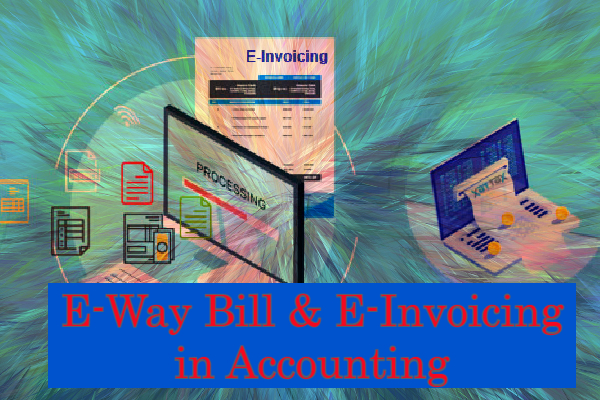Streamlining Accounting Systems with E-Way Bill and E-Invoicing in Accounting
In recent years E-Way Bill and e-invoicing in Accounting, the digitization of accounting systems has revolutionized the way businesses operate. Two crucial advancements in this realm are the implementation of E-way bills and E-invoicing. These digital tools have simplified and streamlined the accounting processes, ensuring efficiency, accuracy, and compliance. This comprehensive guide will delve into the intricacies of E-way bills and E-invoicing, exploring their significance, benefits, implementation, and impact on modern accounting systems.
E-way bills are electronic documents generated for the movement of goods in compliance with applicable tax regulations. They serve as proof of shipment and are required for the transportation of goods beyond a specified value threshold. Here are the key aspects of E-way bills:
a. Purpose and Importance:
E-way bills are vital for ensuring transparency, preventing tax evasion, and facilitating the seamless movement of goods across state borders. They replace traditional paper-based transportation documents, eliminating paperwork, reducing errors, and expediting the movement of goods.
b. Key Components:
E-way bills contain essential details such as supplier and recipient information, product details, invoice number, transportation mode, and distance traveled. They are generated electronically and are assigned a unique identification number for tracking and verification purposes.
c. Generating and Validating E-Way Bills:
Businesses can generate E-way bills through designated online portals or integrated accounting software systems. The information provided in the E-way bill must be accurate and aligned with the corresponding invoice and other related documents. Proper validation and authentication processes ensure the legitimacy of the E-way bill.
E-invoicing is an electronic invoicing system that automates the generation, transmission, and processing of invoices between businesses and their customers. It simplifies invoicing procedures, enhances efficiency, and reduces errors. Let’s examine the key aspects of E-invoicing:
a. Benefits of E-Invoicing:
Implementing E-invoicing brings several advantages, including improved accuracy, faster processing times, reduced costs, enhanced data security, and simplified reconciliation processes. It enables seamless integration between accounting systems, reducing manual data entry and human errors.
b. Standardization and Interoperability:
E-invoicing adheres to specific data standards, ensuring uniformity and compatibility across various accounting software platforms. It enables the automated exchange of invoices, irrespective of the software or systems employed by the trading partners.
c. Regulatory Compliance:
E-invoicing complies with tax regulations and reporting requirements. It provides a digital trail of transactions, ensuring transparency, and simplifying tax audits. By automating tax calculations and ensuring real-time data synchronization with tax authorities, E-invoicing facilitates seamless compliance with tax obligations.
The integration of E-way bills and E-invoicing with accounting systems offers substantial benefits for businesses. It enables end-to-end automation of the supply chain, ensuring smooth coordination between invoicing, transportation, and accounting processes. Here’s how the integration works:
a. Seamless Data Transfer:
Integrated accounting systems can automatically populate E-way bill data from the invoice, eliminating the need for manual data entry. This minimizes errors, saves time, and improves operational efficiency.
b. Real-time Updates and Reconciliation:
The integration allows for real-time updates on the status of E-way bills and invoices. Accounting systems can reconcile data from E-way bills and E-invoices, providing accurate and up-to-date financial information.
c. Enhanced Compliance and Reporting:
With the integration of E-way bills and E-invoicing, accounting systems can ensure compliance with tax regulations, generate accurate tax reports, and facilitate seamless tax filing processes. It reduces the risk of non-compliance and associated penalties.
Conclusion:
E-way bills and E-invoicing have transformed accounting systems by streamlining processes, enhancing accuracy, and promoting compliance. The integration of these digital tools with accounting systems enables businesses to achieve greater operational efficiency, reduced costs, and improved transparency. By leveraging E-way bills and E-invoicing, organizations can stay ahead in an increasingly digital business landscape, ensuring smoother supply chain management and accounting operations.

Leave a Reply